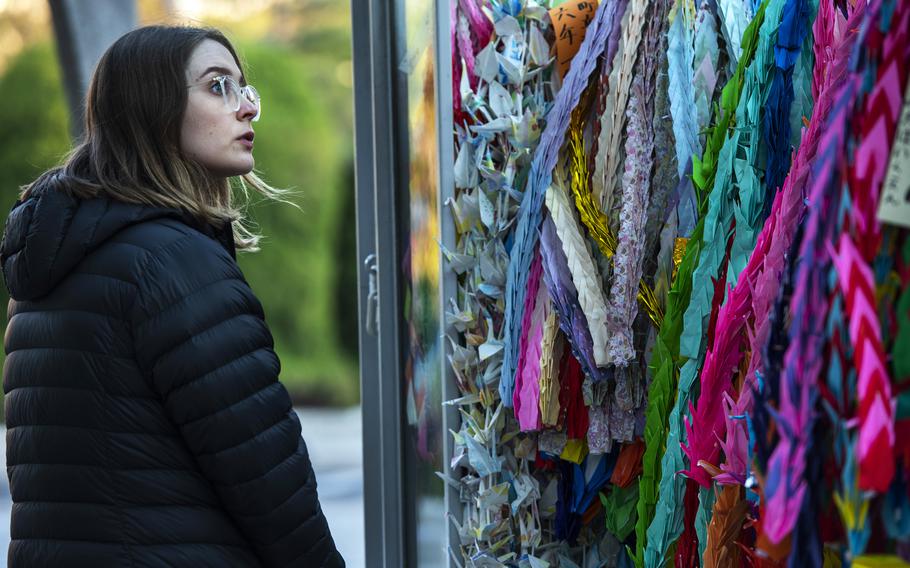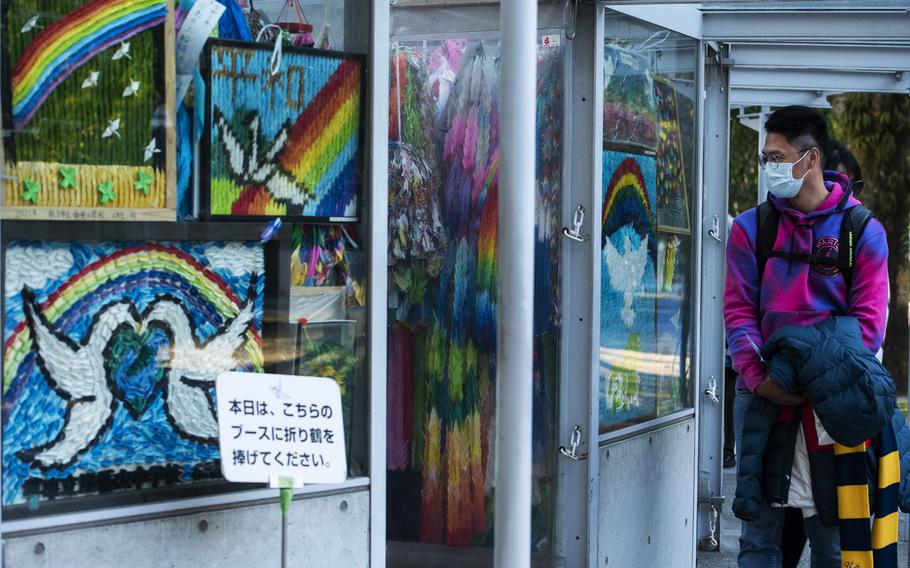Asia-Pacific
Hiroshima atomic bomb victim’s family hopes to add her origami cranes to UNESCO list
Stars and Stripes March 7, 2023

Kate Chapman, visiting from Australia, admires the origami cranes displayed at Peace Memorial Park in Hiroshima, Japan, Feb. 28, 2023. (Jonathan Snyder/Stars and Stripes)
TOKYO — The family of a girl who folded paper cranes in hopes of surviving leukemia after the 1945 Hiroshima bombing hopes to add her story to UNESCO’s world memory program.
Yuji Sasaki, whose aunt Sadako Sasaki died at age 12 as a result of radiation exposure from the atomic blast, said the family plans to apply for the UNESCO Memory of the World next year. They hope to have Sadako’s items, including some of her famous origami cranes, registered by 2025, in time for the 80th anniversary of the end of World War II.
“We need to rush to make sure that we tell what happened in the past to the future generation,” Sasaki, vice chairman of Sadako Legacy, a nonprofit organization set up by Sadako’s family, told Stars and Stripes by phone Thursday.
Her family hopes that items connected to Sadako will relay to future generations the tragedy of WWII and the atomic bombing as the generation that experienced them disappears, Yuji Sasaki said.
Sadako was in Hiroshima on Aug. 6, 1945, the day the U.S. dropped the first atomic bomb used in war. Sadako, age 2 at the time, developed leukemia at age 10 and died at age 12.
She spent eight months in a Hiroshima hospital, where she folded origami cranes. Japanese tradition holds that someone who folds 1,000 cranes will have their get-well wish fulfilled.
Her story became a symbol of peace and denuclearization around the world.
Sasaki compared Sadako’s story to that of Anne Frank, a Jewish girl whose diaries of her days hiding from the Nazis during WWII are registered with UNESCO’s Memory of the World Program.
The program aims to promote “preservation of the world’s documentary heritage, particularly in areas affected by conflict and/or natural disaster,” according to the UNESCO website.
Sasaki said the story of his aunt’s paper cranes, like Frank’s diaries, has spread around the world.
“We want to register her story for Memory of the World, so it can be a symbol for world peace just like Anne Frank,” he said.
The Sasaki family is in the planning stage, but they are thinking of registering items displayed at the Hiroshima Peace Museum, such as the paper cranes that Sadako folded, her medical record while she was fighting leukemia, a memo she wrote on her test results and a list of donors who helped build The Children’s Peace Monument, inspired by Sadako’s death.
Her nephew said the foundation wants to jointly apply for the UNESCO list with the Harry S. Truman Presidential Library and Museum, which displays Sadako’s paper cranes donated by the Sadako Legacy. Truman’s grandson, Clifton Truman Daniel, shares the same vision of reconciliation of feelings for both U.S. and Japanese people, Sasaki said.

Jason Wang, visiting from Taiwan, looks at origami cranes displayed at Peace Memorial Park in Hiroshima, Japan, Feb. 28, 2023. (Jonathan Snyder/Stars and Stripes)
Today, visitors can see paper cranes folded by people around the world wishing for world peace that are displayed at the Children's Peace Monument at Hiroshima Peace Memorial Park.
“It’s quite sobering to see this sort of tangible action being taken by such young people,” Kate Chapman, visiting from Australia, told Stars and Stripes on Tuesday at the park.
“After visiting the museum, I had a lot of emotions come up, not happy ones, but this makes me feel hopeful and happy,” Carolina Dicksinson, visiting from California, said Tuesday. “I think that it is great that the children are involved with this, and it helps them remember why they are doing this, so it continues history through a positive tactile sensation for them.”